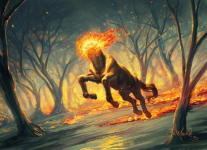O Ilusionista
Captain 100K
Brazilian folklore/mythology may not be very well known to some people, so I thought it would be cool to share a tad here for more people to know, as it has some interesting things.
Saci (or Saci-pererê)
The Saci is a mischievous one‑legged black (or mulatto) boy from Brazilian folklore. He smokes a clay pipe and wears a magical red cap that allows him to vanish and reappear, often within a whirlwind. Known for playful but troublesome pranks, he embodies a blend of indigenous Tupi‑Guarani, African, and European mythological roots.
Origins and characteristics (in brief):


The Curupira is a fiery‑haired, small forest guardian from Tupi‑Guarani tradition. With backward‑turned feet that create deceptive footprints and piercing whistles, he misleads and frightens hunters and loggers who harm the forest. Revered as an ancient indigenous protector, he punishes those who destroy nature through cunning illusions and supernatural strength.
The Mapinguari is a tall, hairy cryptid of Amazonian folklore, often compared to a “Brazilian Bigfoot.” It emits a foul stench, sometimes has backward-facing feet, a cyclopean eye, and a gaping mouth on its belly. A feared forest guardian or predator, it lingers in remote jungles, inspiring both dread and mystery.

The Mula sem Cabeça (“Headless Mule”) is a terrifying creature from Brazilian folklore—often a cursed woman transformed into a fiery-headed mule. She gallops through countryside at night, emitting blazing fire where her head should be, neighing loudly, and spreading fear. Her legend blends Iberian origins with colonial-era moral tales

The Cuca is a fearsome bogeywoman in Brazilian folklore, often portrayed as an ugly old witch with a crocodile head who lurks at night to snatch disobedient children. Her legend was popularized by Monteiro Lobato’s O Saci and later by the TV series Sítio do Picapau Amarelo
More info:

 en.wikipedia.org
en.wikipedia.org

 caminhoslanguages.com
caminhoslanguages.com
Saci (or Saci-pererê)

The Saci is a mischievous one‑legged black (or mulatto) boy from Brazilian folklore. He smokes a clay pipe and wears a magical red cap that allows him to vanish and reappear, often within a whirlwind. Known for playful but troublesome pranks, he embodies a blend of indigenous Tupi‑Guarani, African, and European mythological roots.Origins and characteristics (in brief):
- Origin: Emerged among the Guarani people in southern Brazil; over time, the legend assimilated African and European elements—such as the pipe habit and the red cap inspired by Portuguese folklore
- Characteristics: A nimble trickster who smokes a pipe, has only one leg, and uses his red cap to control his magic (invisibility, whirlwinds). People traditionally believe he can be captured by stealing his cap or trapping him inside a bottle during a dust devil
Curupira


The Curupira is a fiery‑haired, small forest guardian from Tupi‑Guarani tradition. With backward‑turned feet that create deceptive footprints and piercing whistles, he misleads and frightens hunters and loggers who harm the forest. Revered as an ancient indigenous protector, he punishes those who destroy nature through cunning illusions and supernatural strength.
- Origin: Rooted in indigenous Brazilian myth, especially among Amazonian Tupi‑Guarani cultures; first recorded in writing by Jesuit José de Anchieta in 1560, embodying a feared protector of the forest.
- Characteristics: Typically depicted as a small, red‑haired (or blazing orange) figure with backward feet; sometimes bald, hairy, or with green/blue teeth. He confuses intruders with false tracks, whistles from nowhere, may mimic voices, ride a peccary, and is appeased with offerings like tobacco or cachaça.
Mapinguari

The Mapinguari is a tall, hairy cryptid of Amazonian folklore, often compared to a “Brazilian Bigfoot.” It emits a foul stench, sometimes has backward-facing feet, a cyclopean eye, and a gaping mouth on its belly. A feared forest guardian or predator, it lingers in remote jungles, inspiring both dread and mystery.- Origin: Rooted in Amazon tribes’ oral traditions; some tales say it was once a shaman punished by gods, while others tie the legend to memories of extinct giant ground sloths.
- Characteristics: Described as a bipedal or quadrupedal giant, with long shaggy fur, backward feet, a belly mouth, single eye, powerful claws, nauseating odor, and near invulnerability.
Mula sem cabeça

The Mula sem Cabeça (“Headless Mule”) is a terrifying creature from Brazilian folklore—often a cursed woman transformed into a fiery-headed mule. She gallops through countryside at night, emitting blazing fire where her head should be, neighing loudly, and spreading fear. Her legend blends Iberian origins with colonial-era moral tales
- Origin: Derived from Iberian (Portuguese and Spanish) legends and brought to Brazil during colonization. In Brazilian tradition, the curse typically affects women who had sexual relations—especially with priests—as a moral punishment.
- Characteristics: Appears as a dark brown or black mule, headless or with its head engulfed in flames, roaring or neighing with terrifying volume, sometimes sobbing like a human. It gallops through the night, often between Thursday and Friday, possibly over seven towns. The curse can be lifted by removing its bridle or drawing its blood.
Cuca

The Cuca is a fearsome bogeywoman in Brazilian folklore, often portrayed as an ugly old witch with a crocodile head who lurks at night to snatch disobedient children. Her legend was popularized by Monteiro Lobato’s O Saci and later by the TV series Sítio do Picapau Amarelo
- Origin: Her roots lie in the Iberian “Coca” or “Coco” — a dragon or bogeyman used by Portuguese and Spanish parents to frighten children — introduced to Brazil during colonization. Monteiro Lobato gave her the reptilian appearance now iconic.
- Characteristics: Typically depicted as a haggard, old woman with a crocodile-like face, fine hearing, and magical abilities. She lives in a dark cave, kidnaps or eats naughty children, and is said to sleep only once every seven years
More info:

Brazilian mythology - Wikipedia

8 Mystical Creatures from Brazilian Folklore | Caminhos Blog
Brazilian folklore is rich in culture, with folk tales, beliefs, traditions, and mystical creatures scattered all throughout Brazil.
 caminhoslanguages.com
caminhoslanguages.com
